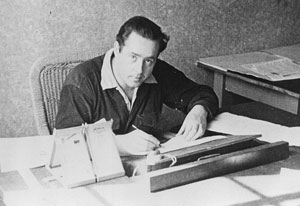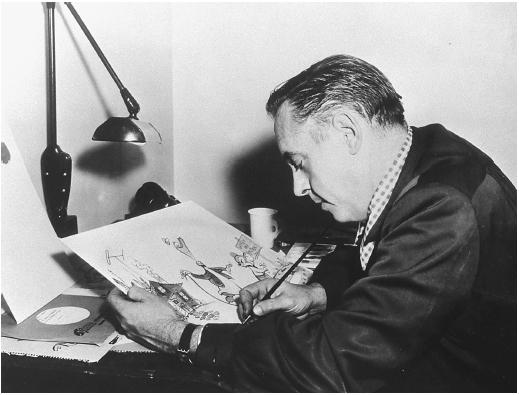Tish-Tash: The Forgotten King of Comedy pt.1

With a career spanning over three decades and four different mediums, Frank Tashlin’s influence on modern comedy is almost immeasurable. Getting his start in animation at
Warner Brothers Studios in 1932, he was one of the few animators in history to make the transition to live action feature filmmaking, where he worked with some of the most widely recognized comedic talent of the post-war era. He wrote sketches for Bob Hope, Lucille Ball and Red Skelton, directed some of Jerry Lewis’ funniest films, and helped shape the original Looney Tunes into the iconic characters we know today. As a feature filmmaker, Tashlin hit a stride of commercial successes beginning with the 1956 film The Girl Can't Help It, followed by the Martin and Lewis film Hollywood Or Bust that same year, Will Success Spoil Rock Hunter? in 1957, and four of Jerry Lewis' early solo films (Rock-A-Bye Baby, The Geisha Boy, Cinderfella, and It'$ Only Money.) New Wave filmmakers such as Jean-Luc Godard and François Truffaut praised these films, and cited Tashlin as a source of inspiration. As Peter Bogdanovich once wrote, Tashlin was “a tremendously able craftsman and one of the most inventive visual gag constructionists of the talkies” (12).
And yet, to this day, Frank Tashlin remains misunderstood – one of the forgotten greats of American comedy. In his essay Taking Tashlin Seriously, Robert Sklar surmises three reasons as to why Tashlin has been ignored by the American film community: “the reputation of comedy as a genre in the period after WWII; critical attitudes toward mass culture in context with the reflexivity in Tashlin’s films; and the aesthetics of the cartoon in relation to concepts of the “real” in the United States during the 1950’s and 60’s” (98). Sklar argues that Tashlin’s work remains pigeonholed as slapstick, and that, due to cultural shifts in the 1960’s towards favoring political comedy and the over-all dismissal of the 50’s as an era marked by triviality, the socio-political themes in his work went unrecognized. Most importantly, Sklar responds to accusations of “tastelessness” and “vulgarity” in Tashlin’s work, calling them “a revenge of discourse, to withdraw from Tashlin what was stereotyped and incomplete to begin with…Saying that he had failed the past was a way of avoiding a recognition of how he had confronted the present.” (101). 
If sensitivity towards 50’s American culture, or lack thereof, is the primary reason for the dismissal of Tashlin as a filmmaker, perhaps now is as good a time as any to revisit his body of work. As it stands, Roger Garcia’s anthology of critical essays entitled Tashlin, published in 1994, remains the sole text on the subject. In it, Garcia writes: “[Tashlin is] a filmmaker who had largely vanished off the cinematic map, despite even his more obvious claims to auteurship – the extended gag, a pop art sensibility, the sardonic eye” (15). More recently, Manhattan’s Film Forum launched a two-week long retrospective of Tashlin’s work, prompting New York Times critic David Kehr to write “More than most of his contemporaries, Tashlin was attuned to the ways in which our own desire betrays us and how easily it can be manipulated to sell things…Frank Tashlin died in 1972, but the world he satirized 50 years ago is still with us, in some ways more than ever”.
These are fairly strong words for a filmmaker who has been dismissed for decades as being ‘vulgar’ and ‘tasteless’. In what ways can we reassess Tashlin’s work between these two polemics? Over the next few days, a selection of posts will attempt to re-evaluate Frank Tashlin under the title Garcia grants him – auteur. 
The Auteur Theory & Tashlinesque
The auteur theory was originally coined in France in the late fifties, after the Liberation, when the ban on American cinema was lifted making it possible for foreign critics to absorb American cinema at great lengths with no preformed bias. Consequentially, it was established that the auteur need not be a member of the Hollywood elite, but often was an author whose work had previously been dismissed or devalued. Likewise, because the theory had never been laid down in concrete terms, it was commonly interpreted loosely to focus either on stylistic or thematic motifs (566).
In terms of the American understanding of the auteur theory, there is perhaps no more comprehensible framework than that presented by Andrew Sarris in his 1962 essay Notes on the Auteur Theory. In it, he defines the auteur as a director who can consistently exhibit recurrent characteristics of style and theme over a group of films. Sarris writes: “the three premises of the auteur theory may be visualized as three concentric circles: the outer circle as technique; the middle circle, personal style; and the inner circle, interior meaning” (563). Sarris argues that it is possible for a director to pass through all three of these circles at any given point in their career. Therefore it becomes important to note that this understanding of the theory “emphasizes the body of a director’s work rather than isolated masterpieces” (563).
In relation to the works of Frank Tashlin, the foundations for the claim of auteurship have already been laid down. As previously stated, Roger Garcia used the term in reference to Tashlin’s visual eye for comedy and satire. However, Jonathan Rosenbaum has laid the most extensive groundwork in his essay titled Tashlinesque. Rosenbaum sought to define Tashlin’s style in relation to other filmmakers, which he felt was represented by “a deliberately dehumanized form of expressionism in the cartoon-like demeanor of the major characters that had a bitter satirical overtone, loud primary colors that also suggested cartoons and comic books, and a spirited vulgarity that comprised a kind of bittersweet response to infantile American energies run amok” (25). Rosenbaum concludes his essay with five distinctly defined terms, which he claims as being “Tashlinesque”:
A) Graphic expression in shapes, colors, costumes, settings, and facial expressions derived from both animated and still cartoons and comic books
B) Sexual hysteria – usually (if not invariably) grounded in the combination of male adolescent lust and 1950’s notions of feminine voluptuousness
C) Vulgar modernism – ‘popular, ironic, somewhat dehumanized mode reflexivity concerned with the specific properties of its medium or conditions of its making’
D) Intertextual film references
E) Contemporary social satire: products, gadgets, fads, trends (26-7)
These five terms, it would appear, make a template for claiming Tashlin as an auteur in relation to Andrew Sarris’ Venn-diagram approach. Term A would represent the outer circle, or technique; Terms C and D the middle circle, or personal style; and Terms B and E as the inner circle, or interior meaning. However Rosenbaum ends his essay without elaborating upon these terms, leaving them simply as a framework definition of Tashlin’s style. It becomes necessary, then, to look deeper into these terms, to surmise their origins and determine their consistency throughout Tashlin’s work in order to verify Tashlin’s status as an auteur...
TO BE CONTINUED...

1 comment:
You write very well.
Post a Comment